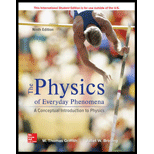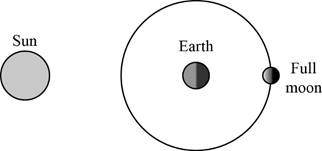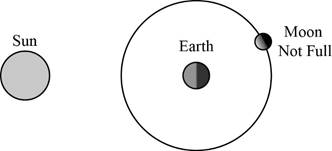
Concept explainers
The period of the moon’s orbit about the Earth is 27.3 days, but the average time between full moons is approximately 29.3 days. The difference is due to the motion of the Earth about the sun.
- a. Through what fraction of its total orbital period does the Earth move in one period of the moon’s orbit?
- b. Draw a sketch of the sun, the Earth, and the moon with the moon in the full moon condition. Then, sketch the position the moon would be in 27.3 days later, when the Earth is in its new position. If the moon is in the same position relative to Earth as it was 27.3 days earlier, is this a full moon?
- c. How much farther would the moon have to go to reach the full moon condition? Show that this represents approximately an extra two days.
(a)
The fraction of total orbital period of earth through which it move in one period of the moon’s orbit.
Answer to Problem 6SP
The fraction of total orbital period of earth through which it move in one period of the moon’s orbit is
Explanation of Solution
Given Info: The period of moon’s orbit about the Earth is
The period of orbital motion of Earth is
Write the expression for the fraction of total orbital period of Earth through which it move in one period of the moon’s orbit.
Conclusion:
Thus the fraction of total orbital period of earth through which it move in one period of the moon’s orbit is
(b)
The sketch of the sun, the Earth and the moon with the moon in the Full moon condition and also the sketch of the position where the moon would be in
Answer to Problem 6SP
The sketch of the sun, the Earth and the moon with the moon in the Full moon condition is

And the sketch of the position where the moon would be in

The moon will not be a full moon yet if the moon is in the same position relative to Earth as it was
Explanation of Solution
When the moon is full, it is on the opposite side of the Earth from the sun. The sketch of the sun, the Earth and the moon with the moon in the Full moon condition is plotted in figure 1.

Figure 1
Write the expression for the angle through which the moon or the Earth advances in one day.
Substitute
Substitute
Find the net angle through the moon advances relative to the Earth.
Find the total angle advanced by the moon in
The moon is not full moon yet.
The sketch of the position where the moon would be in

Figure 2
Conclusion:
Thus the sketch of the sun, the Earth and the moon with the moon in the Full moon condition is plotted in figure 1 and the sketch of the position where the moon would be in
(c)
The extra angle through which the moon have to go to reach the full moon condition and to show it represents approximately an extra two days.
Answer to Problem 6SP
The extra angle through which the moon have to go to reach the full moon condition is
Explanation of Solution
From part (b), the angle advanced by moon in
Find the time taken to cover
Conclusion:
Thus the extra angle through which the moon have to go to reach the full moon condition and to show it represents approximately an extra two days.
Want to see more full solutions like this?
Chapter 5 Solutions
Physics of Everyday Phenomena
- Astronomical observatrions of our Milky Way galaxy indicate that it has a mass of about 8.01011 solar masses. A star orbiting on the galaxy’s periphery is about 6.0104 light-years from its center. (a) What should the orbital period of that star be? (b) If its period is 6.0107 years instead, what is the mass of the galaxy? Such calculations are used to imply the existence of other matter, such as a very massive black hole at the center of the Milky Way.arrow_forward(a) One of the moons of Jupiter, named Io, has an orbital radius of 4.22 108 m and a period of 1.77 days. Assuming the orbit is circular, calculate the mass of Jupiter, (b) The largest moon of Jupiter, named Ganymede, has an orbital radius of 1.07 109 m and a period of 7.16 days. Calculate the mass of Jupiter from this data, (c) Are your results to parts (a) and (b) consistent? Explain.arrow_forward(a) One of the moons of Jupiter, named Io, has an orbital radius of 4.22 108 m and a period of 1.77 days. Assuming the orbit is circular, calculate the mass of Jupiter, (b) The largest moon of Jupiter, named Ganymede, has an orbital radius of 1.07 109 m and a period of 7.16 days. Calculate the mass of Jupiter from this data, (c) Are your results to parts (a) and (b) consistent? Explain.arrow_forward
- Two planets in circular orbits around a star have speed of v and 2v . (a) What is the ratio of the orbital radii of the planets? (b) What is the ratio of their periods?arrow_forwardThe Hubble Space Telescope orbits the surface of the Earth at an altitude of 568 km. (a) What is the orbital speed of the telescope? (b) What is the period of the telescope?arrow_forwardAn undiscovered planet, many lightyears from Earth, has one moon in a periodic orbit. This moon takes 2010 × 103 seconds (about 23 days) on average to complete one nearly circular revolution around the unnamed planet. If the distance from the center of the moon to the surface of the planet is 235.0 × 106 m and the planet has a radius of 3.30 × 106 m, calculate the moon's radial acceleration ?c .arrow_forward
- According to Kepler's third law of planetary motion, the mean distance D, in millions of miles, from a planet in our solar system to the sun is related to the time P, in years, that it takes for the planet to complete a revolution around the sun, and the relationship is D = 93P 2/3. It takes the planet Pluto 248 years to complete a revolution around the sun. What is the mean distance from Pluto to the sun? What is the mean distance from Earth to the sun? Give your answers to the nearest million miles. from pluto to sun _____ million miles from earth to sun _____ million milesarrow_forwardThe average distance between Earth and the Sun is 1.5 ✕ 1011 m. (a) Calculate the average speed of Earth in its orbit (assumed to be circular) in meters per second (b) What is this speed in miles per hour? Please answer Barrow_forwardModel the Moon's orbit around the Earth as an ellipse with the Earth at one focus. The Moon's farthest distance (apogee) from the center of the Earth is rA = 4.05 ✕ 108 m, and its closest distance (perigee) is rP = 3.63 ✕ 108 m. (a) Calculate the semimajor axis of the Moon's orbit. (Enter your answer to at least three significant figures.) m(b) How far is the Earth from the center of the Moon's elliptical orbit? m(c) Use a scale such as 1 cm → 108 m to sketch the Earth-Moon system at apogee and at perigee and the Moon's orbit. (Submit a file with a maximum size of 1 MB.)arrow_forward
 College PhysicsPhysicsISBN:9781305952300Author:Raymond A. Serway, Chris VuillePublisher:Cengage Learning
College PhysicsPhysicsISBN:9781305952300Author:Raymond A. Serway, Chris VuillePublisher:Cengage Learning Physics for Scientists and Engineers: Foundations...PhysicsISBN:9781133939146Author:Katz, Debora M.Publisher:Cengage Learning
Physics for Scientists and Engineers: Foundations...PhysicsISBN:9781133939146Author:Katz, Debora M.Publisher:Cengage Learning Principles of Physics: A Calculus-Based TextPhysicsISBN:9781133104261Author:Raymond A. Serway, John W. JewettPublisher:Cengage Learning
Principles of Physics: A Calculus-Based TextPhysicsISBN:9781133104261Author:Raymond A. Serway, John W. JewettPublisher:Cengage Learning College PhysicsPhysicsISBN:9781285737027Author:Raymond A. Serway, Chris VuillePublisher:Cengage Learning
College PhysicsPhysicsISBN:9781285737027Author:Raymond A. Serway, Chris VuillePublisher:Cengage Learning University Physics Volume 1PhysicsISBN:9781938168277Author:William Moebs, Samuel J. Ling, Jeff SannyPublisher:OpenStax - Rice University
University Physics Volume 1PhysicsISBN:9781938168277Author:William Moebs, Samuel J. Ling, Jeff SannyPublisher:OpenStax - Rice University Glencoe Physics: Principles and Problems, Student...PhysicsISBN:9780078807213Author:Paul W. ZitzewitzPublisher:Glencoe/McGraw-Hill
Glencoe Physics: Principles and Problems, Student...PhysicsISBN:9780078807213Author:Paul W. ZitzewitzPublisher:Glencoe/McGraw-Hill





